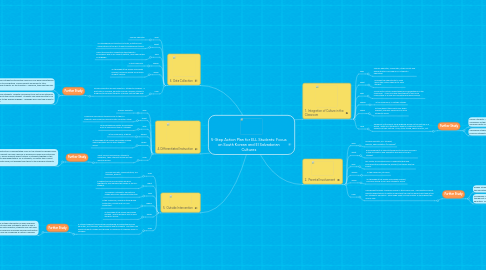
1. 1. Integration of Culture in the Classroom
1.1. Who
1.1.1. Primary educator, classmates, other faculty and administrators involved in ELL student's education.
1.2. What
1.2.1. Provides the opportunity to learn about the culture specific to each student.
1.3. Why
1.3.1. To promote cultural understanding and acceptance in the classroom. It also can help the student(s) feel more comfortable in a new and overwhelming environment.
1.4. Where
1.4.1. In the classroom, in outside studies
1.5. When
1.5.1. All throughout the school year when relevant, primarily should occur upon student's arrival.
1.6. How
1.6.1. Research a little about each language as well as the culture as a whole. Invite ELL students to share in classroom certain aspects of their culture: food, story-telling, show-and-tell, ect.
1.6.1.1. Further Study
1.6.1.1.1. Korean Students: Invite students to investigate the uniqueness of the Hangul alphabet. Have students learn to speak and write a word and share with the class.
1.6.1.1.2. Salvadorian Students: Bring in native foods for students to experience.
2. 2. Parental Involvement
2.1. Who
2.1.1. Primary educator, ELL student, parents, administration (if needed)
2.2. What
2.2.1. Encouragement of parents/guardians to become involved in the acclimation and education process of the ELL student.
2.3. Why
2.3.1. Will foster an increased level of understanding and communication between the student, the family and the school.
2.4. Where
2.4.1. In the classroom, at home
2.5. When
2.5.1. All throughout the school year when relevant, primarily should occur upon student's arrival.
2.6. How
2.6.1. Hold parent-teacher conference early in the school year. Ask questions about parental expectations to better understand the role the parents will take in the ELL student's education. Encourage open communication all throughout the school year.
2.6.1.1. Further Study
2.6.1.1.1. Korean Students: Parents are generally very involved in the educational process and should respond to feedback.
2.6.1.1.2. Salvadorian Students: Family most likely has a high level of respect for the teacher but may not be used to taking an active role in the student's education. Encourage and foster more involvement and communication.
3. 3. Data Collection
3.1. Who
3.1.1. Primary educator
3.2. What
3.2.1. A comprehensive collection of tests, activities and observations of the ELL student's achievement levels.
3.3. Why
3.3.1. Helps the educator understand the student's proficiency level in all subject matters, most specifically in language.
3.4. Where
3.4.1. In the classroom
3.5. When
3.5.1. All throughout the school year when relevant, primarily should occur upon student's arrival.
3.6. How
3.6.1. Primary educator will document ELL student's progress. If past data is available, educator should compare student's progress to previous students of similar culture/age level.
3.6.1.1. Further Study
3.6.1.1.1. Korean students: Many students entering the classroom may have had extensive English training prior to immigrating. Korean parents are known to tutor extensively to prepare students for the transition. Therefore, they may take less time to acclimate.
3.6.1.1.2. Salvadorian students: Parental involvement may not be as extensive compared to the Korean student. Students may have had little to no exposure to the English language. Language skills may take longer to develop.
4. 4. Differentiated Instruction
4.1. Who
4.1.1. Primary educator
4.2. What
4.2.1. Classroom curriculum tailored more to the ELL student's level based of previous data collection study.
4.3. Why
4.3.1. To encourage and foster an increased level of learning for the ELL student.
4.4. Where
4.4.1. In the classroom, at home
4.5. When
4.5.1. All throughout the school year when needed. Should primarily occur upon student's arrival.
4.6. How
4.6.1. Tailor curriculum based on student's readiness, their interests as well as their learning profile.
4.6.1.1. Further Study
4.6.1.1.1. Korean and Salvadorian students: Here instruction is differentiated more on the student's individual level. Again, prior experience and parental involvement can play a big role in proficiency levels and continuing growth. Encourage independent reading, group different levels/cultures of students together in the classroom to work on assignments. Have a high expectations for all students, no matter their current achievement levels. Don't make assignments easier, but perhaps tailor them to the individual student's interests.
5. 5. Outside Intervention
5.1. Who
5.1.1. Primary educator, administrators, ELL teachers, parents
5.2. What
5.2.1. A support group of educators working together to best address the needs of the ELL student.
5.3. Why
5.3.1. To address a student's educational needs with more specified instruction.
5.4. Where
5.4.1. In the classroom, smaller outside group instruction, private one-on-one instruction
5.5. When
5.5.1. All throughout the school year when needed. Should primarily occur upon student's arrival.
5.6. How
5.6.1. A student support team should be gathered including the primary educator, ELL teachers, administrators and/or parents. The team can assess student's needs and develop a curriculum to address areas of struggle.
5.6.1.1. Further Study
5.6.1.1.1. Korean Students and Salvadorian students: Again, the level of outside intervention is again assessed on an individual level. Prior experience, parental involvement at home and a student's ability all play a role in how much intervention is needed. Based off of previous data collection, students may just need a few extra assignments or may need to be removed from the classroom and given specified instruction by an ELL teacher. Assessments should be ongoing and IEPs may be considered an option if needed.

